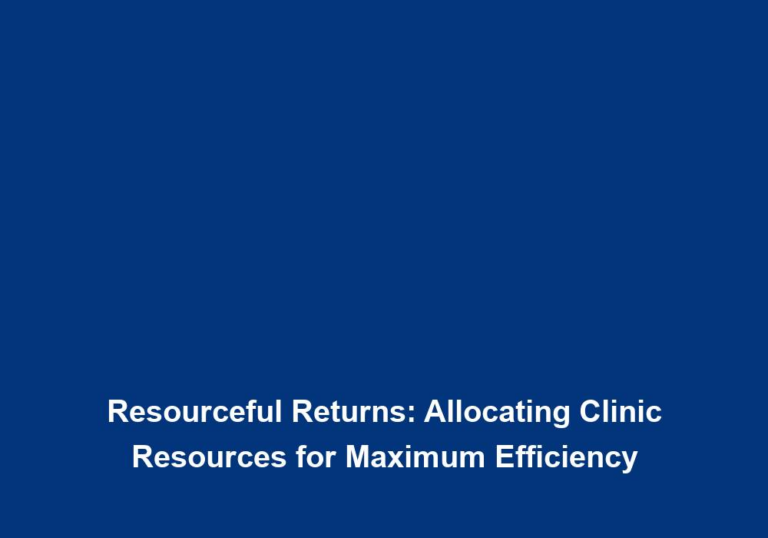Budget Breakdown: Strategies for Efficiently Allocating Medical Resources
In the ever-evolving field of healthcare, efficiently allocating medical resources is of paramount importance. With limited budgets and increasing demand for quality care, healthcare organizations must employ strategic approaches to optimize resource allocation. This article explores various strategies that can help healthcare providers make informed decisions when it comes to budgeting and resource allocation.
Importance of Efficient Resource Allocation in Healthcare
Efficient resource allocation is crucial in healthcare for several reasons. Firstly, it ensures that limited resources, such as finances, staff, and equipment, are utilized optimally to provide the best possible care to patients. By prioritizing the allocation of resources based on need and impact, healthcare organizations can ensure that critical areas receive the necessary attention and investment. For example, investing in technology that improves patient outcomes or reducing wait times for critical procedures can greatly enhance the quality of care provided.
Secondly, efficient resource allocation helps healthcare organizations meet the increasing demand for services while managing costs effectively. By analyzing relevant data, such as patient demographics, utilization rates, and costs, healthcare organizations can identify trends and patterns that can inform resource allocation decisions. This data-driven decision making allows organizations to identify areas of over-utilization or under-utilization of specific resources and reallocate them accordingly. This not only helps in meeting the increasing demand for services but also ensures that resources are utilized optimally, reducing unnecessary costs.
Lastly, efficient resource allocation allows for the equitable distribution of healthcare services, ensuring that everyone has access to necessary care regardless of their socioeconomic status. Collaboration and partnerships with other healthcare organizations, community clinics, or research institutions can provide opportunities for efficient resource allocation. Sharing resources, expertise, and best practices can reduce costs and enhance the quality of care. For example, pooling resources for specialized equipment or sharing staff across multiple locations can lead to significant cost savings and improved access to care for underserved populations.
Understanding the Budgeting Process
Before delving into the strategies for efficient resource allocation, it’s important to understand the budgeting process in healthcare organizations. The budgeting process typically involves the following steps:
-
Assessment of Needs: Healthcare organizations need to identify the specific needs and priorities. This could include investments in technology, infrastructure, staffing, or patient care initiatives. By conducting a thorough assessment of needs, healthcare organizations can prioritize their resource allocation efforts based on the areas that require the most attention.
-
Estimation of Resources: Once the needs are identified, healthcare organizations need to determine the available financial resources that can be allocated to meet those needs. This includes analyzing revenue streams, grants, and other funding sources. By estimating the available resources, healthcare organizations can have a clear understanding of the financial constraints and make informed decisions regarding resource allocation.
-
Allocation Decision-Making: Making informed decisions regarding the allocation of resources is a critical step in the budgeting process. Healthcare organizations need to prioritize investments and consider potential trade-offs. By prioritizing based on need and impact, healthcare organizations can ensure that resources are allocated to areas that will have the most significant positive impact on patient care. This step involves careful consideration of the potential benefits and costs associated with each allocation decision.
-
Implementation and Monitoring: After the resource allocation decisions are made, healthcare organizations need to execute the budget plan and continuously monitor the allocation of resources to ensure compliance and effectiveness. This involves monitoring key performance indicators, seeking feedback from stakeholders, and staying updated on industry best practices. Continuous evaluation and adjustment are necessary to ensure that the resource allocation strategies remain effective and aligned with the changing needs and priorities.
Strategies for Efficient Resource Allocation
Now that we understand the budgeting process, let’s explore some strategies for efficiently allocating medical resources:
1. Prioritization based on Need and Impact
One effective strategy is to prioritize resource allocation based on the needs of the healthcare organization and the potential impact on patient care. This involves identifying areas where additional resources will have the most significant positive impact and focusing on those areas first. By conducting a thorough needs assessment, healthcare organizations can identify critical areas that require immediate attention and investment. This could include investing in technology that improves patient outcomes, reducing wait times for critical procedures, or addressing staffing shortages in high-demand areas. Prioritizing based on need and impact ensures that resources are allocated to areas that will have the most significant positive impact on patient care.
2. Data-Driven Decision Making
Data-driven decision making plays a crucial role in resource allocation. By analyzing relevant data, such as patient demographics, utilization rates, and costs, healthcare organizations can identify trends and patterns that can inform resource allocation decisions. For instance, data may reveal areas of over-utilization or under-utilization of specific resources, allowing organizations to reallocate resources accordingly. By leveraging data, healthcare organizations can make informed decisions about the allocation of resources, ensuring that they are utilized optimally and aligned with the changing needs of the patient population.
3. Collaboration and Partnerships
Collaboration and partnerships with other healthcare organizations, community clinics, or research institutions can provide opportunities for efficient resource allocation. Sharing resources, expertise, and best practices can reduce costs and enhance the quality of care. For example, pooling resources for specialized equipment or sharing staff across multiple locations can lead to significant cost savings. By collaborating with external partners, healthcare organizations can access additional resources and expertise, enabling them to optimize their resource allocation efforts. This collaboration can also help in addressing resource gaps in underserved areas and improving access to care for vulnerable populations.
4. Continuous Evaluation and Adjustment
Efficient resource allocation requires continuous evaluation and adjustment. Healthcare organizations must regularly assess the effectiveness of resource allocation strategies and make necessary adjustments based on changing needs and priorities. This includes monitoring key performance indicators, seeking feedback from stakeholders, and staying updated on industry best practices. By continuously evaluating resource allocation strategies, healthcare organizations can identify areas for improvement and make necessary adjustments to ensure that resources are allocated optimally. This iterative approach allows for the refinement of resource allocation strategies over time, leading to improved efficiency and effectiveness.
5. Prevention and Early Intervention
Investing in prevention and early intervention programs can result in long-term cost savings and more efficient resource allocation. By focusing on preventing chronic diseases or detecting issues early, healthcare organizations can reduce the need for costly treatments and hospitalizations. This approach allows for the allocation of resources towards proactive and preventive measures rather than reactive interventions. For example, implementing vaccination programs, promoting healthy lifestyle choices, and conducting regular screenings can help in preventing the development of chronic conditions and reducing the burden on healthcare resources. By investing in prevention and early intervention, healthcare organizations can optimize their resource allocation efforts and improve the overall efficiency and sustainability of healthcare systems.
Conclusion
Efficiently allocating medical resources is a complex task that requires careful planning and decision making. By prioritizing needs, utilizing data, fostering collaborations, continuously evaluating strategies, and investing in prevention, healthcare organizations can optimize resource allocation and provide high-quality care. Implementing these strategies will not only improve patient outcomes but also enhance the overall efficiency and sustainability of healthcare systems. By continuously refining resource allocation efforts based on changing needs and priorities, healthcare organizations can ensure that limited resources are utilized optimally and aligned with the evolving demands of the patient population.







